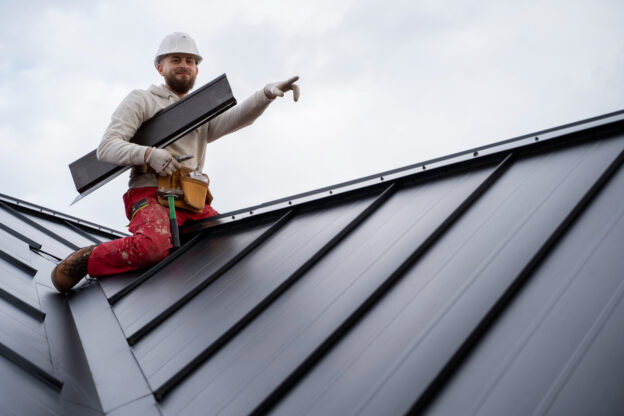Your roof is one of the most important parts of your home. It keeps the rain out and protects you from the sun. But how do you know when it’s time to get a new one? Knowing when to replace your roof can save you a lot of trouble and money down the road.
Sometimes, the signs are easy to see, like cracked and curling shingles or rusted flashing. Other times, it’s a bit trickier, with issues showing up inside your house as water stains or even higher energy bills. The age of the roof plays a part too—older roofs are less likely to hold up during storms.
Weather conditions, like severe storms or constant sun exposure, can take a heavy toll on roofs. Keeping an eye on these signs helps you decide when replacement might be necessary. A clear understanding now will save you from surprises later.
Visible Damage on Roof Surface
Keeping a close watch on your roof’s surface for visible damage is crucial to maintaining its health. Cracked, curling, or missing shingles are clear signs that your roof needs attention. These issues can allow water to seep in, leading to leaks and structural damage. Regularly inspecting and replacing damaged shingles helps to prevent these problems from escalating.
The appearance of moss or algae is another problem to watch for. While it might seem harmless, moss can trap moisture, which deteriorates the shingles over time. Algae, on the other hand, can cause unsightly dark streaks that reduce your home’s curb appeal. Cleaning the roof with appropriate solutions or installing zinc strips can help control moss and algae growth.
Damaged or rusted flashing is a critical concern as well. Flashing seals the spaces around roof edges, chimneys, and vents, and any damage can lead to leaks. Rusted or bent flashing should be repaired or replaced promptly to keep your roof watertight. Regular checks of your roof’s surface ensure that these visible issues are addressed quickly, keeping your home protected.
Interior Warning Signs
Paying attention to interior warning signs is essential for catching roof problems before they worsen. Water stains on the ceiling or walls are a major red flag. These stains often indicate leaks from your roof that have penetrated the home. Promptly locating and fixing leaks helps avoid further damage to your property.
Sagging spots in the attic can indicate structural issues with the roof. They might result from prolonged exposure to moisture or insufficient support. Regular inspections of your attic space can catch these problems early, saving you from costly repairs down the line.
Increased energy bills can also serve as a warning sign. If you notice a sudden spike in energy costs, it may be due to poor insulation or ventilation in the roof. This inefficiency forces heating and cooling systems to work harder. Investigating and improving any ventilation or insulation issues can help reduce energy bills and increase your home’s comfort. Keeping an eye on these interior signs can help ensure your roof remains in excellent condition.
Age and Wear of Roofing Materials
Understanding the age and wear of your roofing materials helps in planning for maintenance and eventual replacement. Different roofing materials come with varied lifespans. For example, asphalt shingles usually last 20 to 25 years, while metal and slate roofs can last upwards of 50 years. Knowing the expected lifespan of your materials can help you budget for replacement and ensure timely upkeep.
Signs of material deterioration include cracking, blistering, or rotting materials. Over time, exposure to the elements can cause these problems, weakening your roof’s structure. Regularly inspecting your roof for such signs can prevent small issues from turning into significant damage.
The importance of routine inspections cannot be overstated. Schedule regular checks to assess the condition of your roof, ideally twice a year, in the spring and fall. This helps catch minor repairs early and maintains the roof’s longevity. Routinely checking your roof ensures it remains in good condition and ready to handle whatever the weather throws at it.
Weather and Environmental Impact
Weather and environmental factors significantly impact your roof’s condition. Damage from recent severe weather events is a frequent issue. Hail, high winds, and heavy rainfall can all compromise your roof’s integrity. After severe weather, inspect your roof for signs of damage like missing shingles or dents in metal components.
The effects of constant exposure to sun and humidity can also degrade roofing materials over time. UV rays cause roofing materials to break down, leading to cracks and weakening of the protective layers. Humidity fosters the growth of mold and mildew, which can rot your roof if not addressed. Conditioning materials like sealants can help extend the life of your roof under these conditions.
The influence of overhanging trees and debris buildup is another consideration. Tree branches can scrape and gouge your roof during windy conditions, while leaves and other debris can clog gutters, causing water damage. Regularly trimming trees and cleaning your roof can help mitigate these risks. Staying on top of these environmental impacts ensures your roof remains strong and effective.
Conclusion
Keeping your roof in top shape requires regular attention and care. By monitoring visible damage, attending to interior warning signs, accounting for the age and wear of materials, and being mindful of environmental factors, you ensure that your roof continues to protect your home effectively. Routine inspections and maintenance are key to catching issues early, saving time and money in the long run.
For all your roofing needs, Sutter Roofing is here to help. Our expert services and knowledgeable team ensure your roof receives the care it deserves. Whether you’re addressing a simple repair or considering a complete overhaul, we’re ready to assist. Contact us today and let us work with you to provide long-lasting roofing services in Santa Rosa tailored to your home’s needs.








